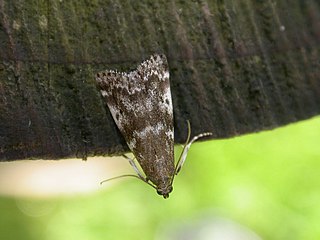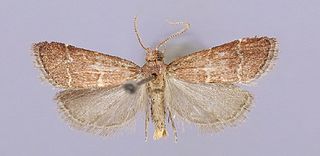
In Greek mythology, the Heliades also called Phaethontides were the daughters of Helios and Clymene, an Oceanid nymph.

Crambidae comprises the grass moth family of lepidopterans. They are variable in appearance, with the nominal subfamily Crambinae taking up closely folded postures on grass stems where they are inconspicuous, while other subfamilies include brightly coloured and patterned insects that rest in wing-spread attitudes.

The Pyralidae, commonly called pyralid moths, snout moths or grass moths, are a family of Lepidoptera in the ditrysian superfamily Pyraloidea. In many classifications, the grass moths (Crambidae) are included in the Pyralidae as a subfamily, making the combined group one of the largest families in the Lepidoptera. The latest review by Eugene G. Munroe and Maria Alma Solis retain the Crambidae as a full family of Pyraloidea.

The Pyraloidea are a moth superfamily containing about 16,000 described species worldwide, and probably at least as many more remain to be described. They are generally fairly small moths, and as such, they have been traditionally associated with the paraphyletic Microlepidoptera.

Ion Heliade Rădulescu or Ion Heliade was a Wallachian, later Romanian academic, Romantic and Classicist poet, essayist, memoirist, short story writer, newspaper editor and politician. A prolific translator of foreign literature into Romanian, he was also the author of books on linguistics and history. For much of his life, Heliade Rădulescu was a teacher at Saint Sava College in Bucharest, which he helped reopen. He was a founding member and first president of the Romanian Academy.

Christian Tell was a Transylvanian-born Wallachian and Romanian general and politician.
Xanthippe or Xantippe was the wife of Socrates.
The Tineodidae or false plume moths are a family of moths with in some cases unusually modified wings: Like in some related moths, the wings of several Tineodidae are decomposed into several rigid spines. This is a small family, with about a global total of 20 species described to date; some undescribed species are known or suspected to exist however. They seem to be of Australian origin, where they are most diverse, but range through the Wallacea to Southeast and South Asia, and into the Pacific to the Marquesas Islands.

Mișu Popp was a Romanian painter and muralist.

Assara terebrella is a moth of the family Pyralidae. It is found in Europe, Korea, Japan (Hokkaido) and eastern Siberia.

Hahncappsia is a genus of moths of the family Crambidae, and the order Lepidoptera.

Scoparia is a grass moth genus of subfamily Scopariinae. Some authors have assigned the synonymous taxon Sineudonia to the snout moth family (Pyralidae), where all grass moths were once also included, but this seems to be in error.

The Phycitinae are a subfamily of snout moths. Even though the Pyralidae subfamilies are all quite diverse, Phycitinae stand out even by standards of their family: with over 600 genera considered valid and more than 4000 species placed here at present, they unite up more than three-quarters of living snout moth diversity. Together with the closely related Epipaschiinae, they are apparently the most advanced lineage of snout moths.

The Galleriinae are a subfamily of snout moths and occur essentially worldwide, in some cases aided by involuntary introduction by humans. This subfamily includes the wax moths, whose caterpillars (waxworms) are bred on a commercial scale as food for pets and as fishing bait; in the wild, these and other species of Galleriinae may also be harmful to humans as pests.

The Chrysauginae are a subfamily of snout moths. They are primarily Neotropical and include about 400 described species.

Heliades is a genus of moths of the family Pyralidae.

Heliades lindae is a species of moth of the family Pyralidae that is endemic to Arizona.

Heliades mulleolella is a species of moth of the family Pyralidae. It is found in the south-eastern United States. Records from Arizona refer to Heliades huachucalis.
Scoparia huachucalis is a moth in the family Crambidae. It was described by Eugene G. Munroe in 1972. It is found in North America, where it has been recorded from Arizona.
Eugene Gordon Munroe was a Canadian entomologist who discovered numerous species of insects. He worked for the Insect Systematics and Biological Control Unit, Entomology Division in Ottawa, Ontario, Canada.















